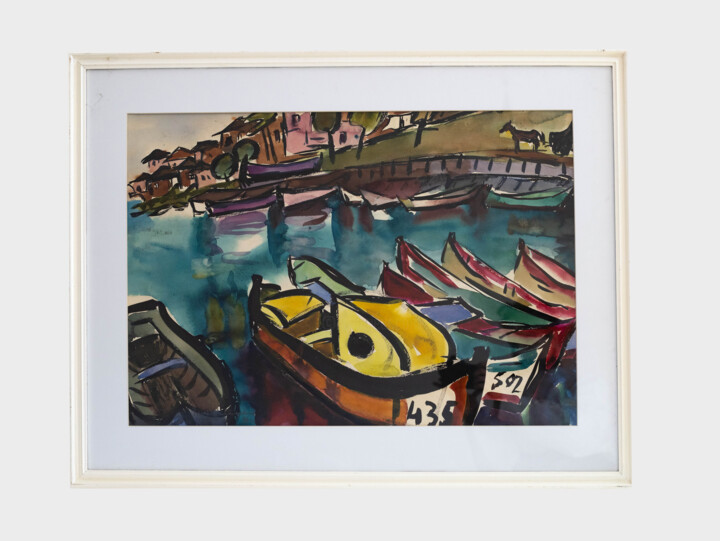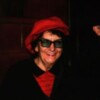





"Boats at the black sea"(Bulgaria) (1962) Schilderij door Iulia Hălăucescu
Meer info
- Verpakking (Doos of kartonnen verpakking) Alle kunstwerken worden verzonden met een premium carrier, zorgvuldig beschermd en verzekerd.
- Tracking Opvolging van de levering tot aan de bezorging bij de koper. Er wordt een tracking nummer verstrekt zodat u het pakket in real-time kunt volgen.
- Vertraging Wereldwijde levering in 3 tot 7 dagen (Schatting)
- Douane niet inbegrepen De prijs is exclusief douanekosten. De meeste landen hebben geen invoerbelasting voor originele kunstwerken, maar het kan zijn dat u de verlaagde btw moet betalen. Douanekosten (indien van toepassing) worden bij aankomst berekend door het douanekantoor en worden apart in rekening gebracht door de vervoerder.
Meer info
- Volgbaar online certificaat van echtheid Echtheidscertificaten kunnen op elk moment online worden geverifieerd door de code van het kunstwerk te scannen.
- Certificering van de Kunstenaarswaarde De experts bestuderen het werk en de carrière van een kunstenaar om een onafhankelijke en vetrouwbare gemiddelde waarde vast te stellen. De gemiddelde waarde stelt de kunstenaar in staat zich voor een bepaalde periode in een prijsklasse te plaatsen. Ook kan aan de deskundige gevraagd worden om een precieze schatting te geven voor een specifiek werk.
Meer info
100% veilig betalen met SSL-certificaat + 3D Secure.
Meer info
-
Origineel Kunstwerk (One Of A Kind)
Schilderij,
Aquarel
op Papier
-
Dimensies
27,6x39,4 in
Afmetingen van het werk alleen, zonder lijst: Hoogte 19,7in, Breedte 27,6in - Staat van kunstwerk Het kunstwerk is in perfecte staat
- Framing Dit kunstwerk is ingelijst (Frame + onder glas)
- Categorieën Schilderijen onder US$ 20.000 Expressionisme Boot
Artwork condition: 9.5/10
Frame condition: 9/10
Original artwork by Iulia Halaucescu
Verwante thema's
Born on the 31st of March 1924 in Tarcau within the Neamț Mountains she has been passionate about art since childhood. She played theater, recited poems, wrote scripts and was fascinated by gypsy dances. Nevermore, she has been selected the class painter for her botanical and anatomical drawings.
During this period, she encounters her teacher Lupu-Chesloi who introduces her to the watercolour techniques, uncovering the enigma of colour and water. This prompts her to be the winner of a competition organized by “Children’s Universe” as well as many other scholar competitions.
In the year of 1943, during the middle of WW2 her life reaches a crossway as she enrolls in the courses of the University of Bucharest where she takes up philosophy as a major. At this time, her artistic career seems to stagnate. However, something she did not yet know was that the universe was merely paving her pathway toward finding her true topos. Within an auto-biography, Iulia states that her study of philosophy has prompted her to better organize her thoughts, reaching essences, as she further confesses that she did not plan on pursuing a career in philosophy, but on organizing her ideas coherently. She takes up private lessons with Schweitzer-Cumpană whom, through guidance and advice imprints the force of colour and form unto the young artist.
In 1948, at the same time with the educational reform she definitively parts ways with her philosophical career and painting devoutly embraces her. She marries Lucius Petronius Hălăucescu, her confident in matter of art, the soul of many of her exhibitions, a Theo Van Gogh. At the debut of their romantic love story, Iulia would communicate through images. It is a suite of watercolour in a vibrant sentimentalism, which would be unequaled in her artistic endeavours, but which marks, beyond its lyrical undertext, her artistic debut with the watercolour technique, a technique for which the artist writes chapter of her own. During this period, the artist gravitates between the techniques of oil and watercolour and at the same, it is the the start of a period of timid but more and more pregnant artistic incursions. As she returns to Piatra Neamț, Iulia shifts her gaze upon the city of Iași, the city where Ștefan Dumitrescu and Nicolae Tonitza excelled. In 1948, as she provides a few paintings and graphical drawings for the regional competition, she is lucky enough to be spotted by Nicolae Baba. His keen eyes immediately spots her particular stamp and her veritable artistic mark and he recommends to her that she should enroll in Belle Art, in the autumn of the year 1949.
There and in Bucharest, after the dismantling of Belle Art the artist polishes a bunch of techniques as well as her vision which she garnered during her private lessons with S.Cumpană.
Prior to becoming “The lady of Romanian watercolour” as she not only imposed herself to the public whom she enthusiastically electrised during each exhibition, but also to the art critics....
-
Nationaliteit:
ROEMENIË

- Geboortedatum : 1924
- Artistieke domeinen: Vertegenwoordigd door een galerij,
- Groepen: Roemeense Hedendaagse Kunstenaars Kunstenaars gepresenteerd door een galerij













